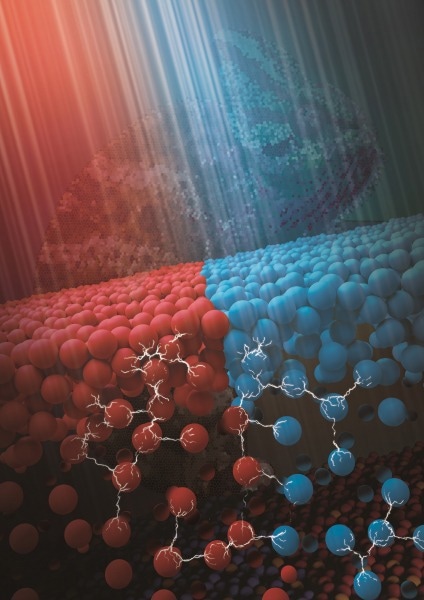As far as nature is concerned, the skin of cephalopods (animals with tentacles fixed to the head) displays incredible camouflage ability.

Novel ink composed of colorful microbeads adapts to the appearance of received light by light-driven separation. Image Credit: The University of Hong Kong
Their skin comprises pigment groups that can sense variations in environmental light conditions and adjust their appearance via the action of pigment cells. Although intricate, this color-changing ability is dependent on a mechanical mechanism in which pigment particles have been folded or unfolded under the control of radial muscles.
Having been motivated by this natural process, a research group headed by Dr. Tang Jinyao from the Department of Chemistry at The University of Hong Kong (HKU) came up with a novel wavelength-selective intelligent colloid system to obtain light-controlled multi-dimensional phase segregation in partnership with researchers from Hong Kong University of Science and Technology and Xiamen University.
The group develops dynamic photochromic nanoclusters by mixing cyan, magenta, and yellow microbeads, thereby obtaining photochromism on a macro scale.
This macroscopic photochromism depends on light-induced vertical phase stratification in the active microbeads mixture, leading to the enhancement of colored microbeads akin to the incident spectrum.
Contrary to present color-changing materials, this new photochromic colloidal swarm depends on reorganizing present pigments instead of producing new chromophores in situ and is, thus, highly trustworthy and programmable.
Their study outcomes offer an easy technique for applications like displays, electronic ink, and active optical camouflage. This constitutes a significant discovery in the field of active matter. The study outcome was recently reported in the renowned academic journal Nature.
Self-actuated active particles are known as micro or nanoparticles that copy the directional swimming of microorganisms in liquid. Lately, they have gained considerable attention in nanoscience and non-equilibrium physics and are being developed for possible biomedical applications.
One of the primary research objectives of active particles is to come up with medical micro or nanorobots based on such particles for non-invasive and drug-delivery surgery.
But, the structure of active particles is very simple, and their driving mechanism and environment perception are considerably restricted.
Specifically, the size and comparatively simple structure of the individual micro or nano active particles curb the intricacy of implementing functions on their body. The difficulty and key to identifying the future application are the way to make active particles with smart characteristics in spite of their simple structure.
The light-powered microswimmers, a kind of self-actuated active particles, have recently come up to create controllable nanorobot, which provides the possibility for functional novel materials and biomedical application as the alignment direction swimmer activity, and interparticle interaction could be readily modified with incident light.
At the same time, light not only induces photosensitive motion in microswimmers but also variations in the efficient interaction between particles.
For instance, photocatalytic reactions could alter the local chemical gradient field, which in turn impacts the movement trajectory of neighboring particles via the diffusion swimming effect, leading to a long-range attraction or repulsion.
In this study performed Tang’s team developed a simple wavelength-selective TiO2 active microbeads system depending on their earlier study on light-powered microswimmers. On being subjected to photoexcitation, the redox reaction on TiO2 particles produces a chemical gradient, which tunes the efficient particle-particle interaction.
That is, the particle-particle interaction could be regulated by integrating incident light of various wavelengths and intensities. TiO2 microbead with various photosensitive activities could be developed by choosing dye sensitization codes with various spectral characteristics.
Through mixing various differently identical TiO2 microbead species loaded with dyes of various absorption spectra and adjusting the incident light spectra, the on-demand particle segregation is identified.
The motivation for identifying particle phase segregation is to regulate the particle aggregation and dispersion in liquid at both micro and macro levels. Efficiently, this led to a novel photo-responsive ink by blending microbeads with various photo-sensitivity that may be employed in electronic paper.
The principle is identical to the pigment clusters in the skin of cephalopods that could sense the light condition of the surroundings and alter the appearance of surroundings pigment cells via their corresponding actions.
The research findings have contributed significantly to advancing our knowledge of swarm intelligence in artificial active materials and have paved the way for designing innovative active smart materials.
Dr. Jinyao Tang, Department of Chemistry, The University of Hong Kong
Tang added, “With this breakthrough, we anticipate the development of programmable photochromic ink that could be utilized in various applications such as e-ink, display ink, and even active optical camouflage ink.”
Journal Reference
Zheng, J., et al. (2023) Photochromism from wavelength-selective colloidal phase segregation. Nature. doi.org/10.1038/s41586-023-05873-4.